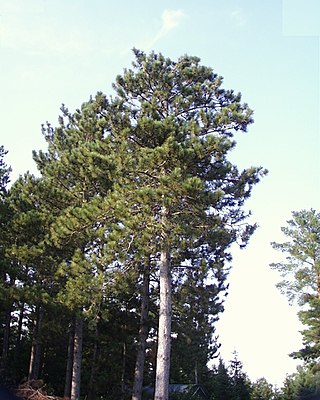
Pinus resinosa, known as red pine, is a pine native to North America.

Pinus serotina, the pond pine, black bark pine, bay pine,marsh pine, or pocosin pine, is a pine tree found along the Southeastern portion of the Atlantic coastal plain of the United States, from southern New Jersey south to Florida and west to southern Alabama. Pond pine distribution may be starting to spread west towards Mississippi and Tennessee.

Pinus glabra, the spruce pine, is a tree found on the coastal plains of the southern United States, from southern South Carolina south to northern Florida and west to southern Louisiana.

Pinus muricata, the bishop pine, is a pine with a very restricted range: mostly in California, including several offshore Channel Islands, and a few locations in Baja California, Mexico. It is always on or near the coast.

Pinus arizonica, commonly known as the Arizona pine, is a medium-sized pine in northern Mexico, southeast Arizona, southwest New Mexico, and western Texas in the United States. It is a tree growing to 25–35 m tall, with a trunk diameter of up to 1.2 m. The needles are in bundles of 3, 4, or 5, with 5-needle fascicles being the most prevalent. This variability may be a sign of hybridization with the closely related ponderosa pine. The cones are single, paired, or in whorls of three, and 5–11 cm long.
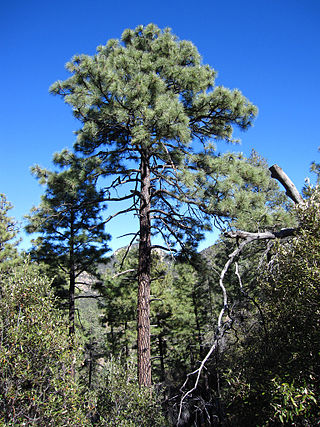
Pinus engelmannii, commonly known as the Apache pine, is a tree of Northern Mexico, in the Sierra Madre Occidental with its range extending a short distance into the United States in southwestern New Mexico and southeastern Arizona. This pine is a medium-sized species with a height of 20–30 metres and a trunk diameter of 35–80 centimetres.

Pinus cembroides, also known as pinyon pine, Mexican pinyon, Mexican nut pine, and Mexican stone pine, is a pine in the pinyon pine group, native to western North America. It grows in areas with low levels of rainfall and its range extends southwards from Arizona, Texas and New Mexico in the United States into Mexico. It typically grows at altitudes between 1,600 and 2,400 metres. It is a small pine growing to about 20 m (66 ft) with a trunk diameter of up to 50 cm (20 in). The seeds are large and form part of the diet of the Mexican jay and Abert's squirrel. They are also collected for human consumption, being the most widely used pine nut in Mexico. This is a common pine with a wide range and the International Union for Conservation of Nature has rated its conservation status as being of "least concern".

Pinus orizabensis, the Orizaba pinyon, is a pine in the pinyon pine group, endemic to central Mexico. It is considered also as a sub-species of Pinus cembroides which is classified as Pinus cembroides subsp. orizabensis D.K.Bailey. It has larger seeds than the type.
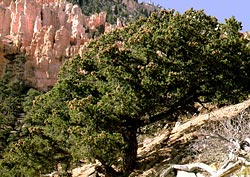
Pinus edulis, the Colorado pinyon, two-needle piñon, pinyon pine, or simply piñon, is a pine in the pinyon pine group whose ancestor was a member of the Madro-Tertiary Geoflora and is native to the United States.

Pinus gerardiana, commonly known as the chilghoza pine or neja, is a pine native to the northwestern Himalayas in Afghanistan, northern Pakistan, Waziristan and northwestern India, growing at elevations of 1,800–3,350 metres (5,910–10,990 ft). It often occurs in association with Cedrus deodara, and Pinus wallichiana.

The Sierra Madre Occidental pine–oak forests are a Temperate broadleaf and mixed forests ecoregion of the Sierra Madre Occidental range from the southwest USA region to the western part of Mexico. They are home to a large number of endemic plants and important habitat for wildlife.

Pinus hartwegii, Hartweg's pine, the Mexican mountain pine, or pino de las alturas, is a pine native to the mountains of Mexico and Central America east to Honduras. It is named after Karl Theodor Hartweg, who described it in 1838.
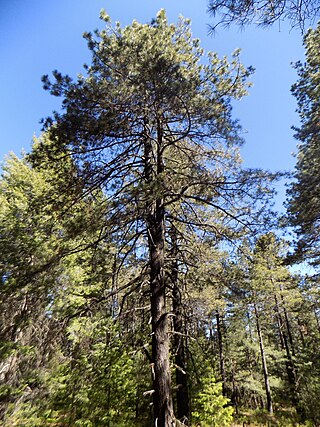
Pinus durangensis, the Durango pine, is a pine tree species endemic to the Sierra Madre Occidental mountain range of north-western Mexico.

The Sierra Madre sparrow, also known as Bailey's sparrow, is an endangered, range-restricted, enigmatic American sparrow. It is endemic to Mexico and is threatened with extinction through habitat loss.

Pinus oocarpa is a species of pine tree native to Mexico and Central America. It is the national tree of Honduras, where it is known as ocote. Common names include ocote chino, pino amarillo, pino avellano, Mexican yellow pine, egg-cone pine and hazelnut pine. It appears that it was the progenitor (original) species that served as the ancestor for some of the other pines of Mexico.
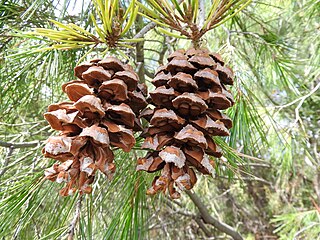
Pinus pinceana, with the common names weeping pinyon and Pince's pinyon pine, is a species of conifer in the family Pinaceae.

Pinus chiapensis is a pine tree species in the family Pinaceae, and is commonly known as Chiapas pine, in Spanish as pino blanco, pinabete, or ocote. Chiapas pine was formerly considered to be a variant of pinus strobus, but is now understood to be a separate species.

Quercus urbani, also known as Quercus urbanii, is a species of oak. It is native to western and central Mexico from Sinaloa, Durango, and Zacatecas to Oaxaca. It was previously synonymized with Quercus pennivenia, but this was restored as an independent species in 2020.
Quercus radiata is an endangered species of oak native to Mexico.




















